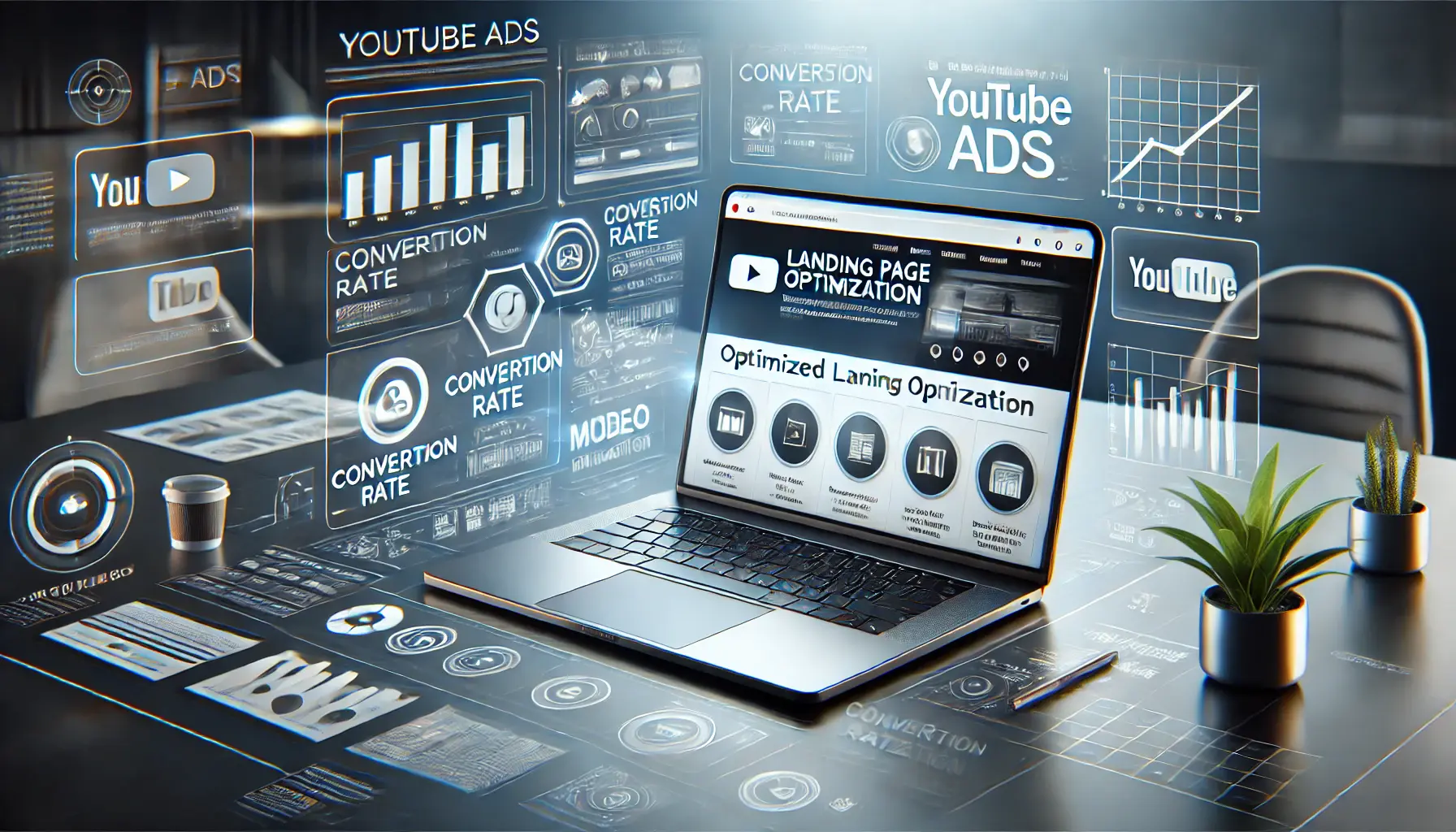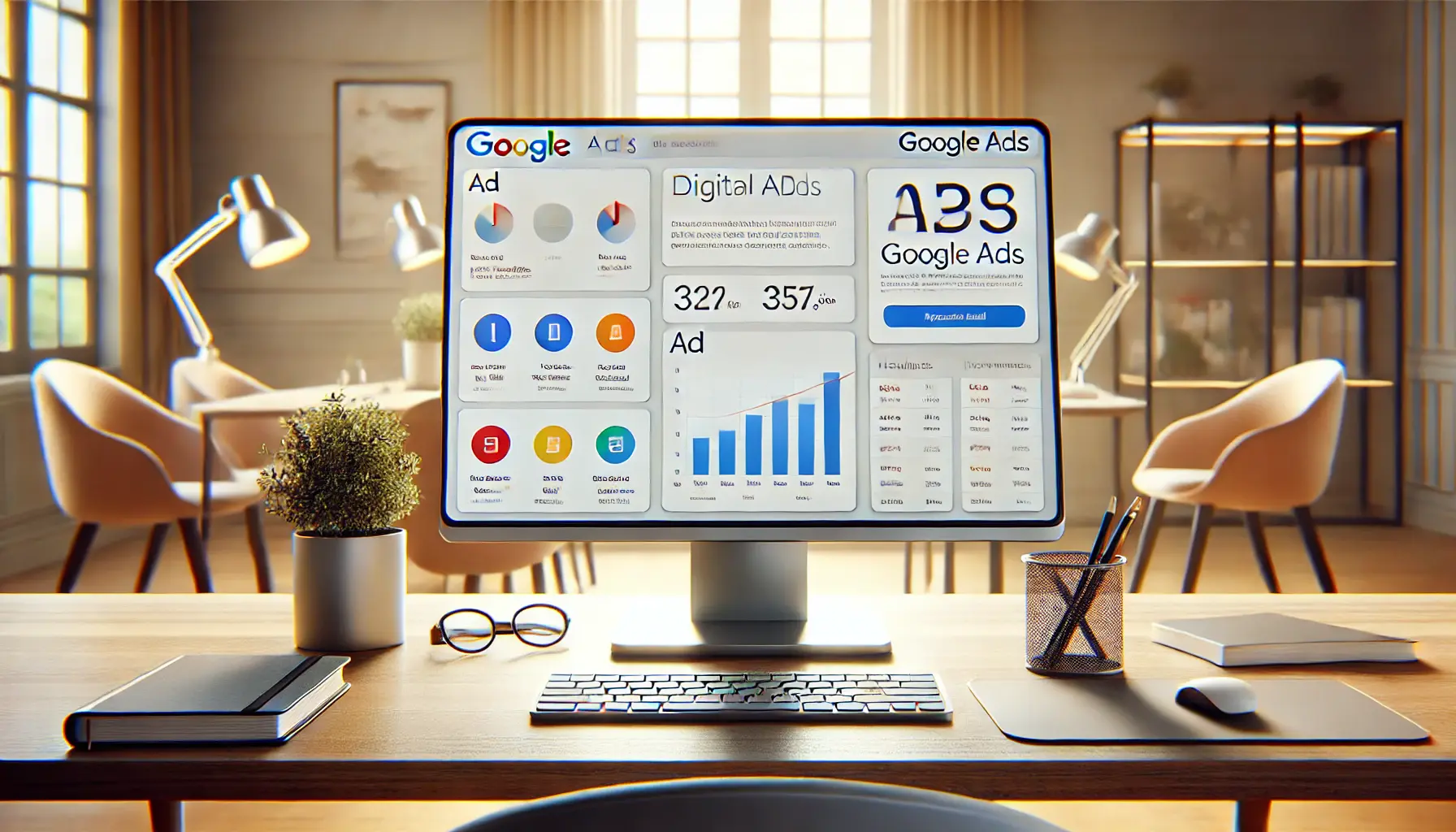YouTube has quickly become one of the most influential video advertising channels, allowing businesses and marketers to reach out to literally billions of viewers across the globe.
Needless to say, much more is needed than just a good idea for an ad to create an attention-grabbing ad capable of changing views into meaningful action.
It takes understanding YouTube ad formats, effective targetingThe process of selecting an audience for an ad based on specific criteria., and tactical optimization for you to ensure that you are getting the most out of your advertising dollars.
Throughout this guide, we are going to break down in detail the four key steps necessary to master video ads on YouTube and equip you with the actionable insights to take on video advertising like a pro.
Understanding YouTube Video Ads
Before unleashing creativity, it is crucial to understand the different types of video ads available on YouTube and how they work.
Each format has its unique advantages and ideal use cases, and choosing just the right type can make all the difference in reaching your target audience more effectively.
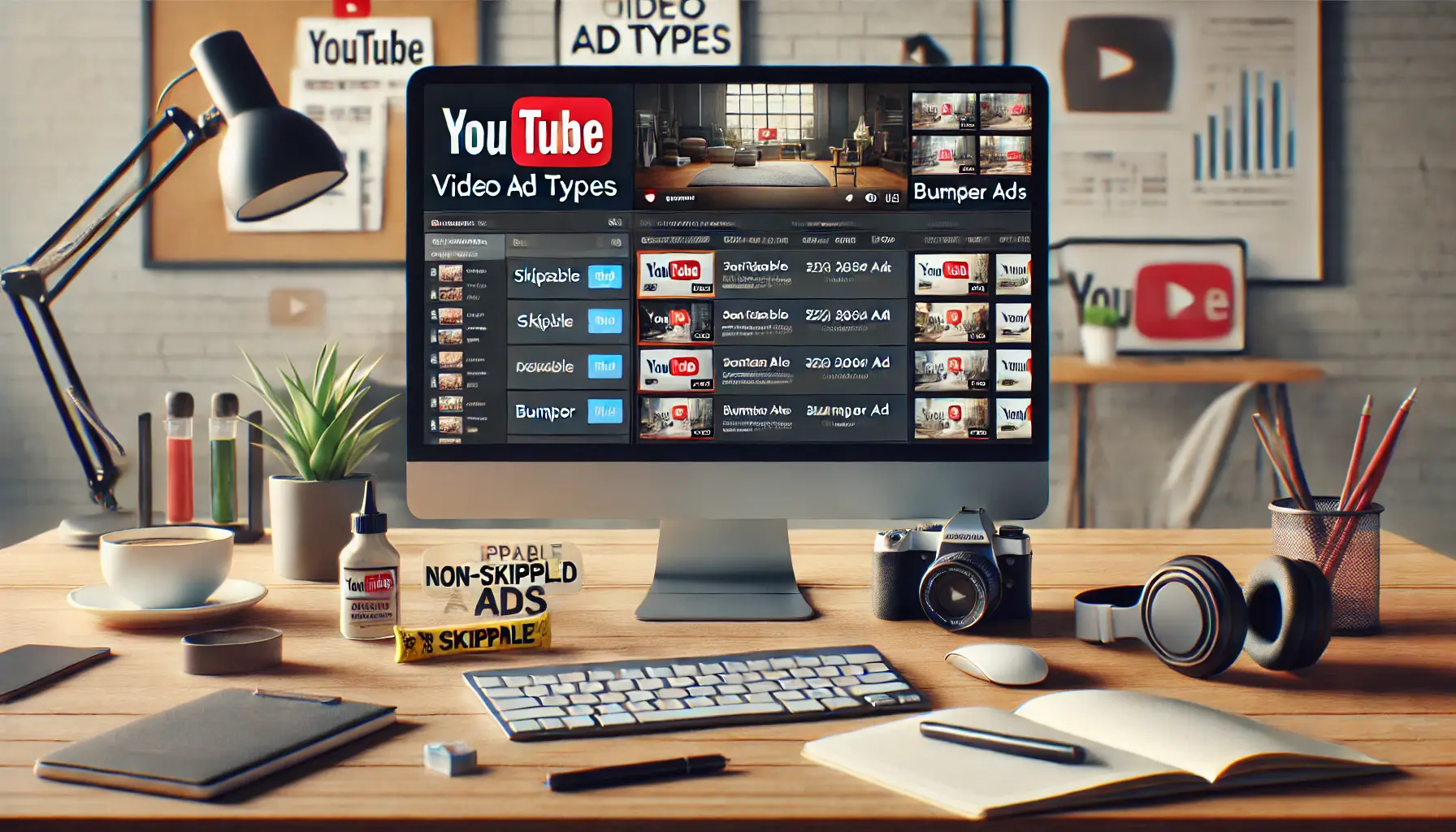
A marketer’s workspace displaying various YouTube ad formats.
Types of YouTube Video Ads
YouTube supports multiple video ad formats that are appropriate for different advertising goals and budgets.
Being familiar with these options helps you make better decisions when planning your campaigns.
- Skippable In-Stream Ads: These video ads play before, during, or after a video and grant the viewer the ability to skip after five seconds. They’re perfect if you’re looking to reach a large audience and give users a choice in continuing to watch your ad.
- Non-Skippable In-Stream Ads: These are ads that aren’t skippable and are usually about 15-20 seconds. They’re really good at communicating a strong brand message fast and may be CPM-based, charged for every thousand impressions.
- Bumper Ads: Six-second ads that play before the main content and cannot be skipped. They’re great for concise, memorable messages and are also CPM-based.
- Discovery Ads: Commonly referred to as TrueView discovery ads, these are ads that run alongside YouTube search results, enticing viewers to click and watch. Discovery ads work best for building an audience of people who are most interested in your content.

A professional workspace displaying YouTube ad placement options.
Ad Placements: Where Your Ads Will Appear
Precisely knowing where your ad is going to turn up on YouTube will help target the right audience at the right time.
YouTube ads can appear in a variety of placements on the platform, catering to different user behaviors and content interactions.
- Search Results: Discovery ads can show up in YouTube’s search results to help capture viewers searching for content related to your product or service.
- Display Pages: Ads can appear on the YouTube homepage, in the recommended video sidebar, or in the display ads space on individual video pages, offering multiple points of visibility.
- Partner Sites: As part of the Google Display Network, YouTube ads can also appear on other partner sites, extending your reach beyond just YouTube.
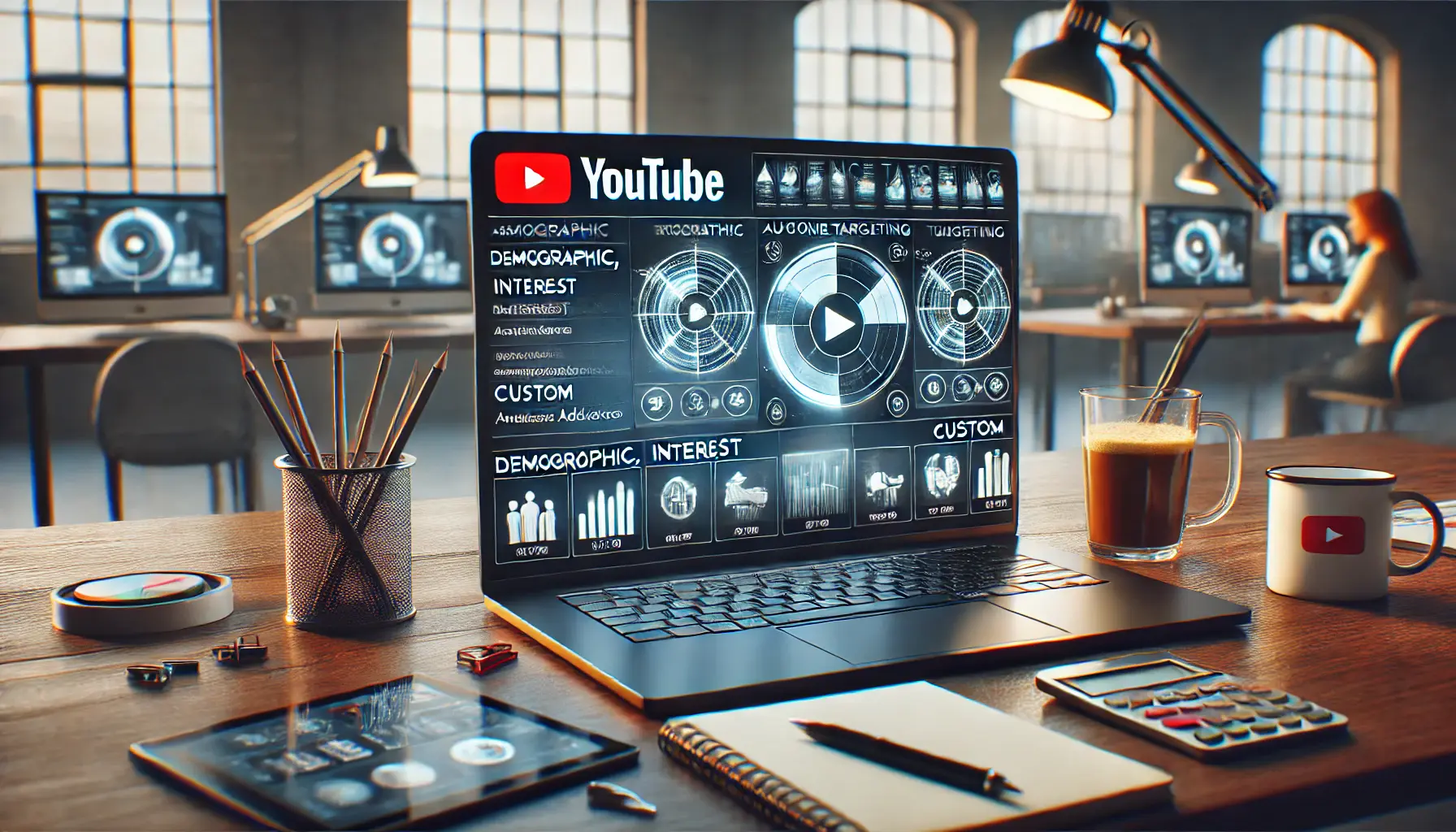
A professional workspace with YouTube targeting options displayed on screen.
YouTube’s Targeting Options
Targeting is the linchpin of any successful video ad campaign.
YouTube’s targeting options enable you to reach highly specific audiences based on everything from demographicsStatistical data of a population, including age, gender, and income. to interests and behaviors.
With proper targeting, you ensure that your ads will appear in front of those most likely to engage and convert.
- Demographic Targeting: Target audiences based on age, gender, household income, and parental status to narrow your reach to the most relevant viewers.
- Interest-Based Targeting: Reach viewers who have shown interest in certain topics, including technology, fitness, or travel.
- Custom Intent and Affinity Audiences: Allows the creation of highly specific audiences based on users’ search intent and affinity toward certain categories.
- Remarketing: Reconnect with viewers who have previously interacted with your channel or visited your website, keeping your brand top of mind.

A professional workspace showing YouTube video ad performance metrics.
Essential Metrics to Track
Success in YouTube video ads is mainly gauged by tracking a few important metrics that speak to performance and engagement.
Keeping tabs on these metrics will be crucial as you refine your ads and build better future campaigns.
- View Rate: Measures the number of people who viewed your ad in comparison to the number of people exposed to it. The view rate tells you how engaging your ad is.
- Click-Through Rate (CTR): Tracks viewers who clicked on your ad, helping you understand how appealing your call-to-action may be.
- Watch Time: Shows how much time viewers are spending watching your video ads, providing insight into how well your ad resonates with your target audience.
- Conversions: Tracks specific actions viewers take after watching, such as purchases or sign-ups, giving insight into ad effectiveness.
Mastering YouTube video ads starts with understanding these key elements.
With a strong foundation in ad formats, placements, targeting, and metrics, you’ll be better equipped to create ads that capture attention and drive results.
Understanding YouTube ad formats and their unique advantages helps maximize your ad’s reach and impact.

A workspace showing a marketer creating an engaging video ad for YouTube.
Crafting Effective Video Ads
Creating effective video ads on YouTube requires a blend of art and science.
It’s not enough to create beautiful content; it’s about communicating your message in a way that resonates with your target audience and inspires action.
Let’s dive into the essential elements of creating effective video ads.

A workspace where a marketer is creating engaging content for a YouTube video ad.
Creating Engaging Content
Engagement is at the heart of any effective video ad.
How do you capture and retain viewers’ attention?
Here are a few ways:
- Start with a Strong Hook: The first few seconds are crucial. Begin with an intriguing question, a surprising fact, or a compelling visual to grab their attention right off the bat.
- Tell a Story: Narratives are powerful tools. Construct a story that supports your brand message and speaks to the emotions of your audience.
- Keep It Concise: Attention spans are short. Deliver your message succinctly to maintain viewer interest throughout the ad.
- Use High-Quality Visuals and Audio: Professional visuals and clear audio enhance credibility and keep viewers engaged.
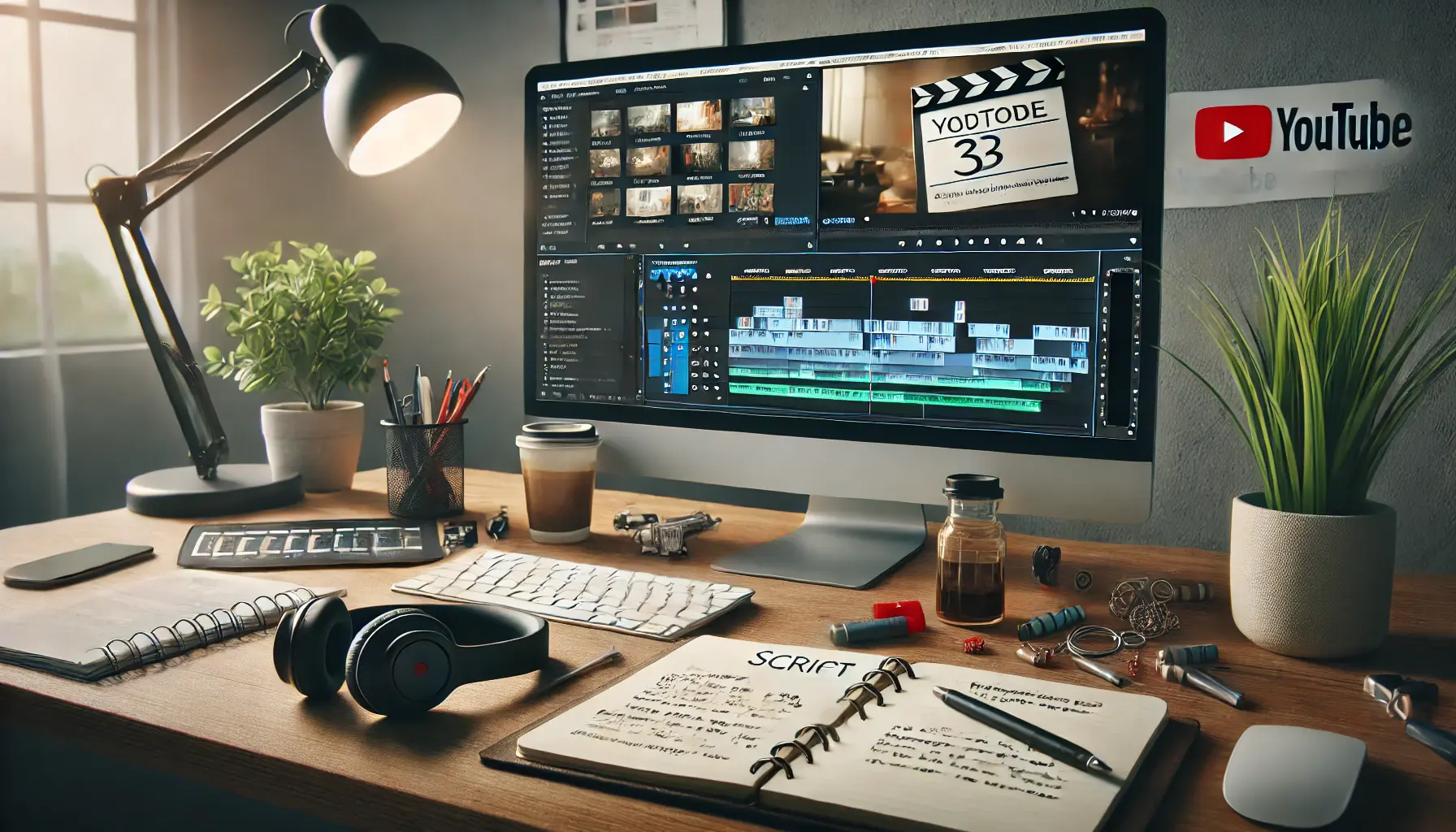
A workspace where a marketer is scriptwriting for a YouTube video ad.
Tips for Effective Scriptwriting
A well-written script is the backbone of your video ad.
Here are some tips to ensure your script is both engaging and effective:
- Know Your Audience: Understand who you are addressing and mold your language and tone to fit that specific audience.
- Focus on Benefits: Highlight how your product or service solves a problem or improves the viewer’s life.
- Include a Clear Call-to-Action (CTA): Guide viewers on what to do next, whether it’s visiting your website, subscribing, or making a purchase.
- Practice Brevity: Use simple words and avoid jargon to make your message easily understandable.
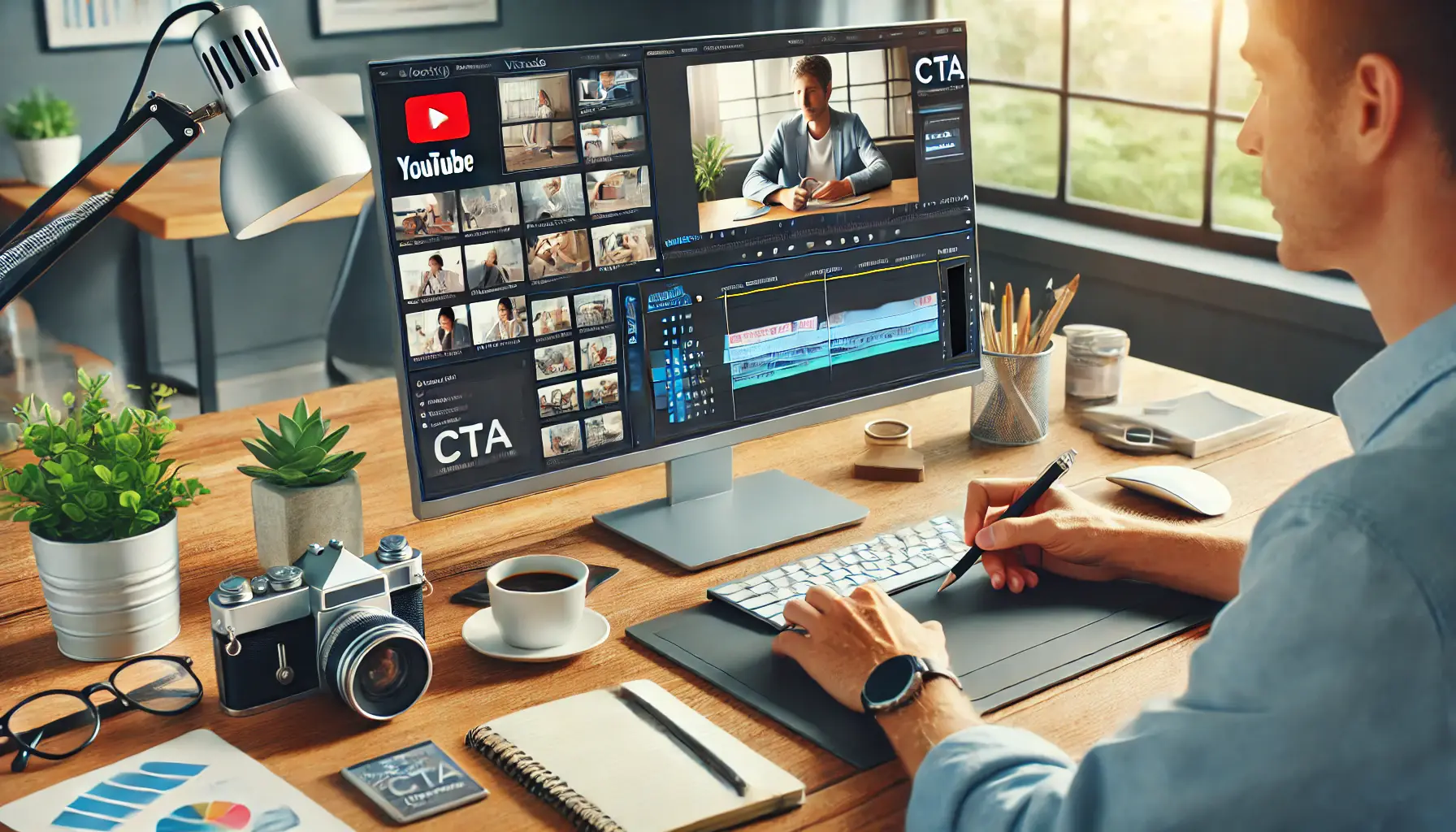
A digital marketing workspace focused on selecting visuals and optimizing the CTA for a YouTube ad.
Choosing the Right Visuals and CTA
The visuals and call-to-action in your ad play a significant role in its effectiveness:
- Align Visuals with Message: Ensure the imagery supports and enhances the narrative of your ad.
- Add Branding Elements: Incorporate your logo and brand colors to strengthen brand identity.
- Display CTA Prominently: Make your call-to-action easy to find and attractive, encouraging immediate action.
- Test Different CTAs: Experiment with various calls-to-action to identify what resonates best with your target audience.
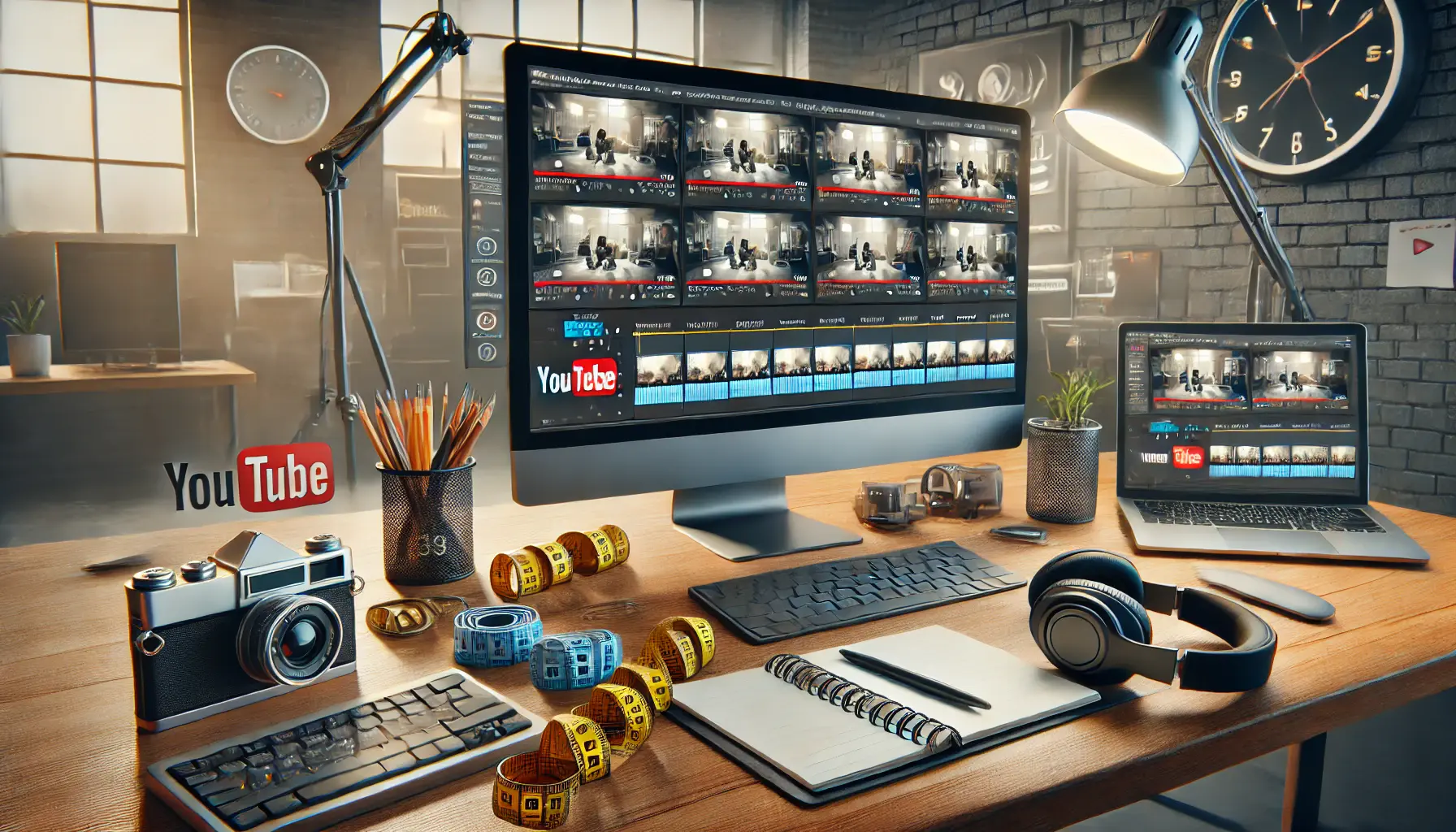
A workspace where a marketer is reviewing video ads of varying lengths for optimization.
Best Practices for Video Length
The length of your video ad can impact its effectiveness:
- Shorter Ads for Awareness: Ads running for 6 to 15 seconds work well for brand awareness, delivering a quick and memorable message.
- Longer Ads for Consideration: Use longer versions, up to 60 seconds, if you want to provide more information or tell a story in greater depth.
- Monitor Drop-Off Rates: Use analytics to determine if viewers are watching your ad to completion and adjust the length accordingly.
By paying attention to these details, you’ll drive impactful engagement and conversions with video ads that capture attention on YouTube.
Effective ads blend creative storytelling with clear CTAs, resonating with viewers and driving engagement.
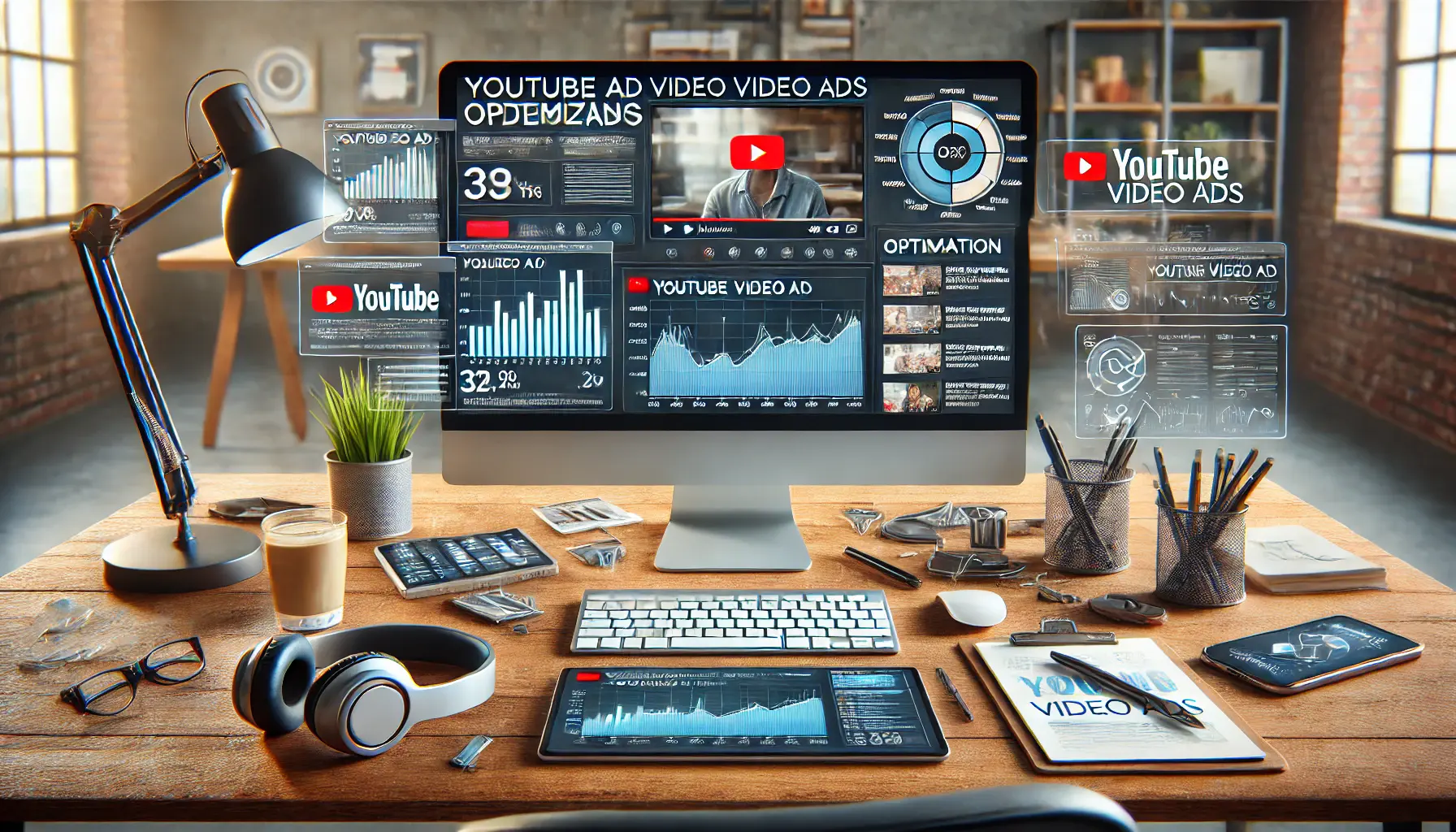
A workspace where a marketer is optimizing YouTube video ads with analytics tools.
Optimizing Your YouTube Video Ads
While designing an attractive video ad is important, ensuring that it performs well in terms of engagement and efficiency is crucial.
Let’s explore some essential strategies to enhance the performance of your YouTube video ads.

A workspace where a marketer is reviewing YouTube ad performance metrics using analytics tools.
Using YouTube Analytics to Track Performance
To understand how your video ads are performing, utilize YouTube Analytics.
This tool provides valuable insights into viewer behavior and ad effectiveness:
- Check Viewership Rates: The percentage of viewers who watch your ad to completion reflects its engagement level.
- Click-Through Rate (CTR) Analysis: Measures how many viewers click through after viewing your ad, indicating the effectiveness of the call-to-action.
- Audience Retention Tracking: Identifies where viewers drop off in your ad, allowing you to adjust content to enhance engagement.
- Demographics Review: Understand the age, gender, and location of your audience for better targeting in future ads.
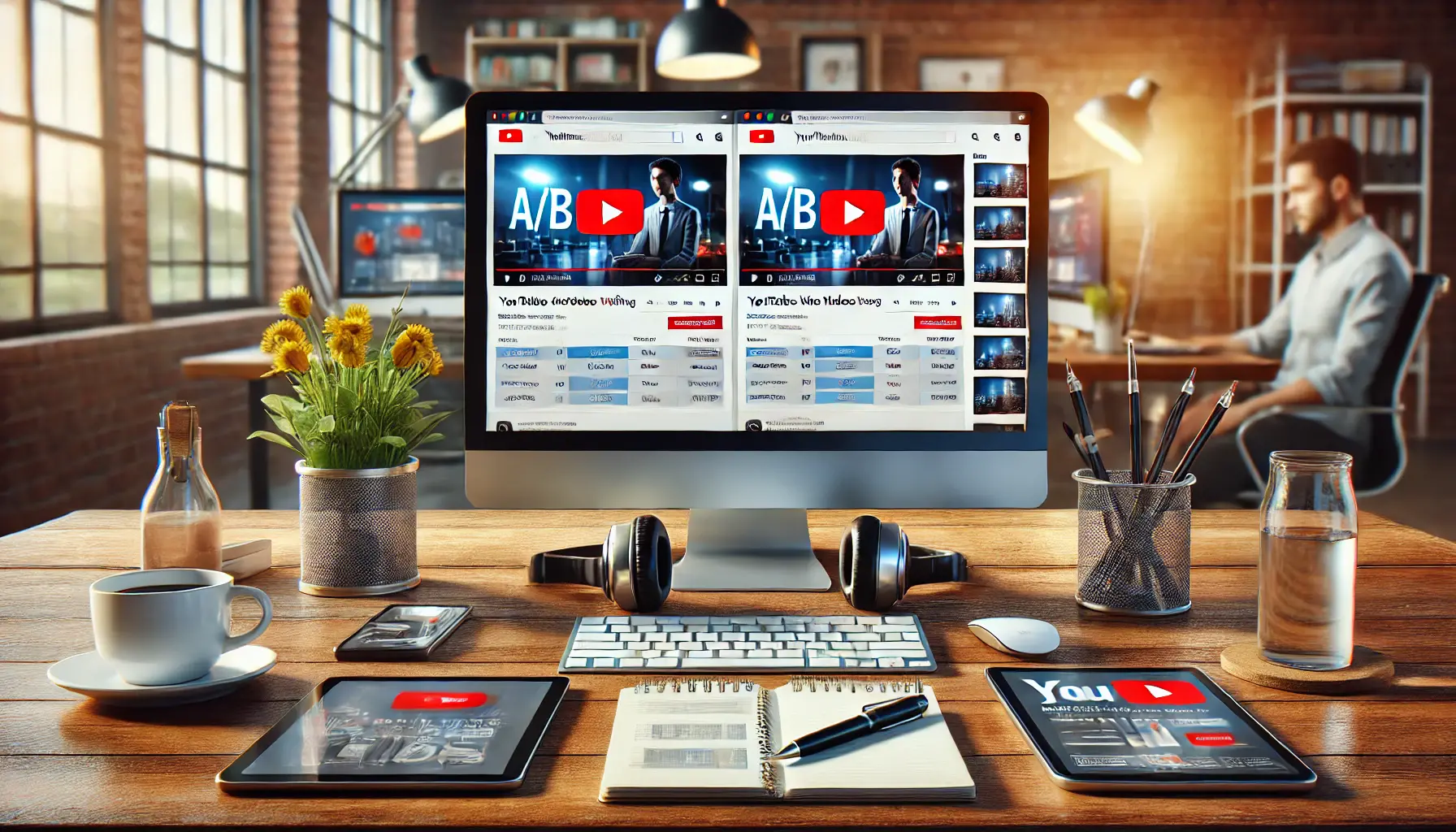
A digital marketing workspace where A/B testing is being done on YouTube video ads.
A/B Testing of Various Creative Variants
Testing different elements of an ad can help you understand what resonates best with your audience:
- Test Several Creatives: Experiment with different video concepts to determine which generates higher engagement.
- Vary CTAs: Show different calls-to-action to identify which encourages more interaction from viewers.
- Adjust Ad Length: Test various ad lengths to find the optimal duration that retains viewer interest.
- Change Targeting Parameters: Modify audience targeting to discover which segments yield the best results.
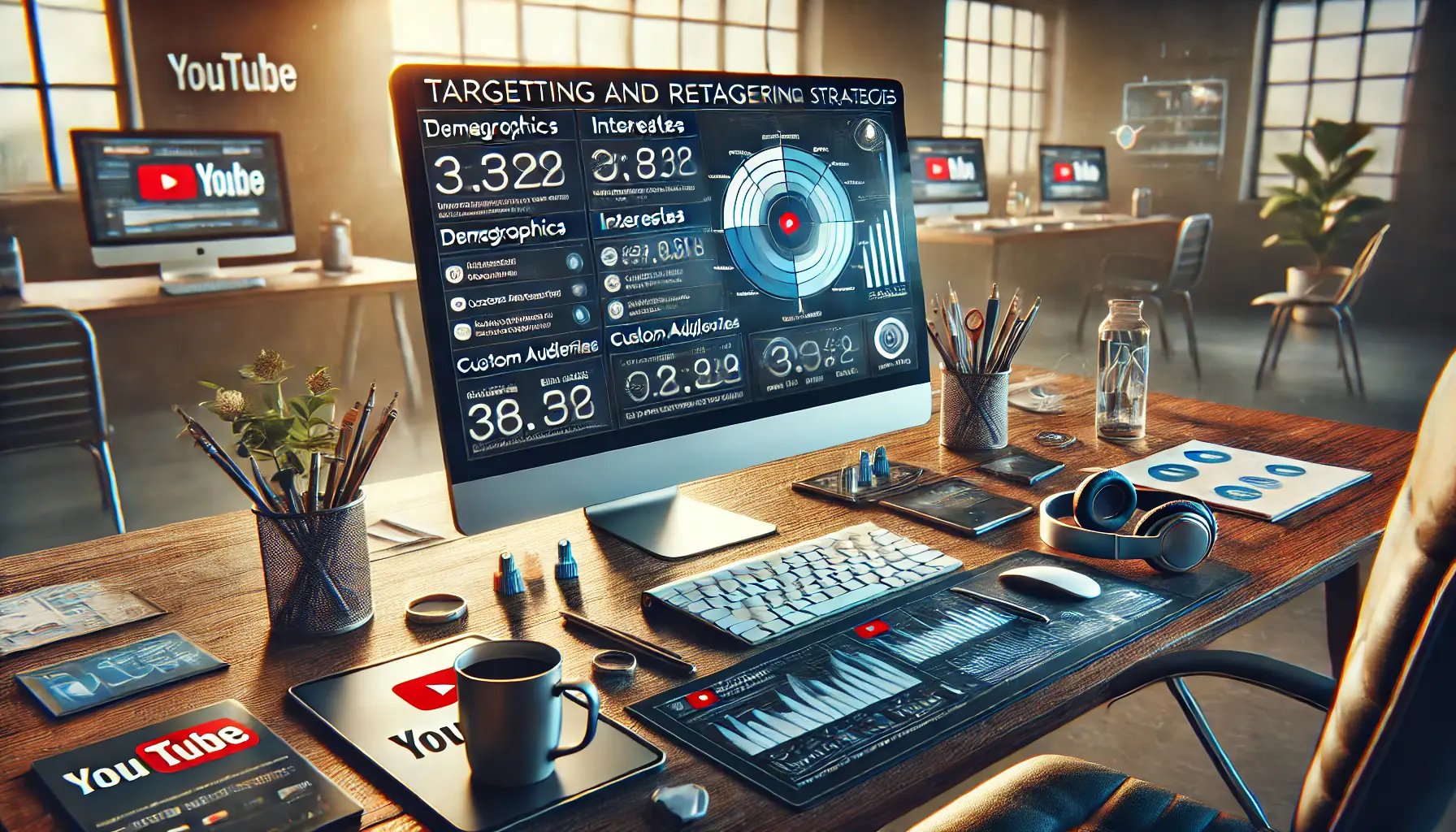
A workspace where a marketer is refining targeting and retargeting strategies for YouTube ads.
Targeting and Retargeting Strategies
Reaching the right audience is essential for ad success.
Here are some effective targeting and retargeting strategies:
- Demographic Targeting: Focus on specific age groups, genders, and locations to reach your ideal customers.
- Interest Targeting: Target viewers with particular interests and online behaviors to make your ads more relevant.
- Remarketing Campaigns: Re-engage users who have previously interacted with your brand to drive more conversions.
- Custom Affinity Audiences: Create affinity audiences that closely align with your ideal target customer profile.

A workspace where a marketer is optimizing ad placement and bidding strategies for YouTube ads.
Ad Placement and Bidding Optimization
Strategic placement and biddingThe process of setting a price for ad placement in an auction-based system. can increase ad visibility and improve cost-effectiveness:
- Choose the Right Ad Format: Select between skippable, non-skippable, or bumper ads depending on your campaign objectives.
- Apply Placement Targeting: Place ads on specific channels or videos that align with your target audience.
- Set Competitive Bids: Adjust bids to balance cost with desired reach and engagement levels.
- Monitor Performance Metrics: Regularly review metrics to refine bidding strategies and optimize budget allocation.
By implementing these optimization techniques, you can enhance the effectiveness of your YouTube video ads, leading to increased engagement and better return on investment.
Regular optimization of targeting, ad content, and placements enhances engagement and ad performance.
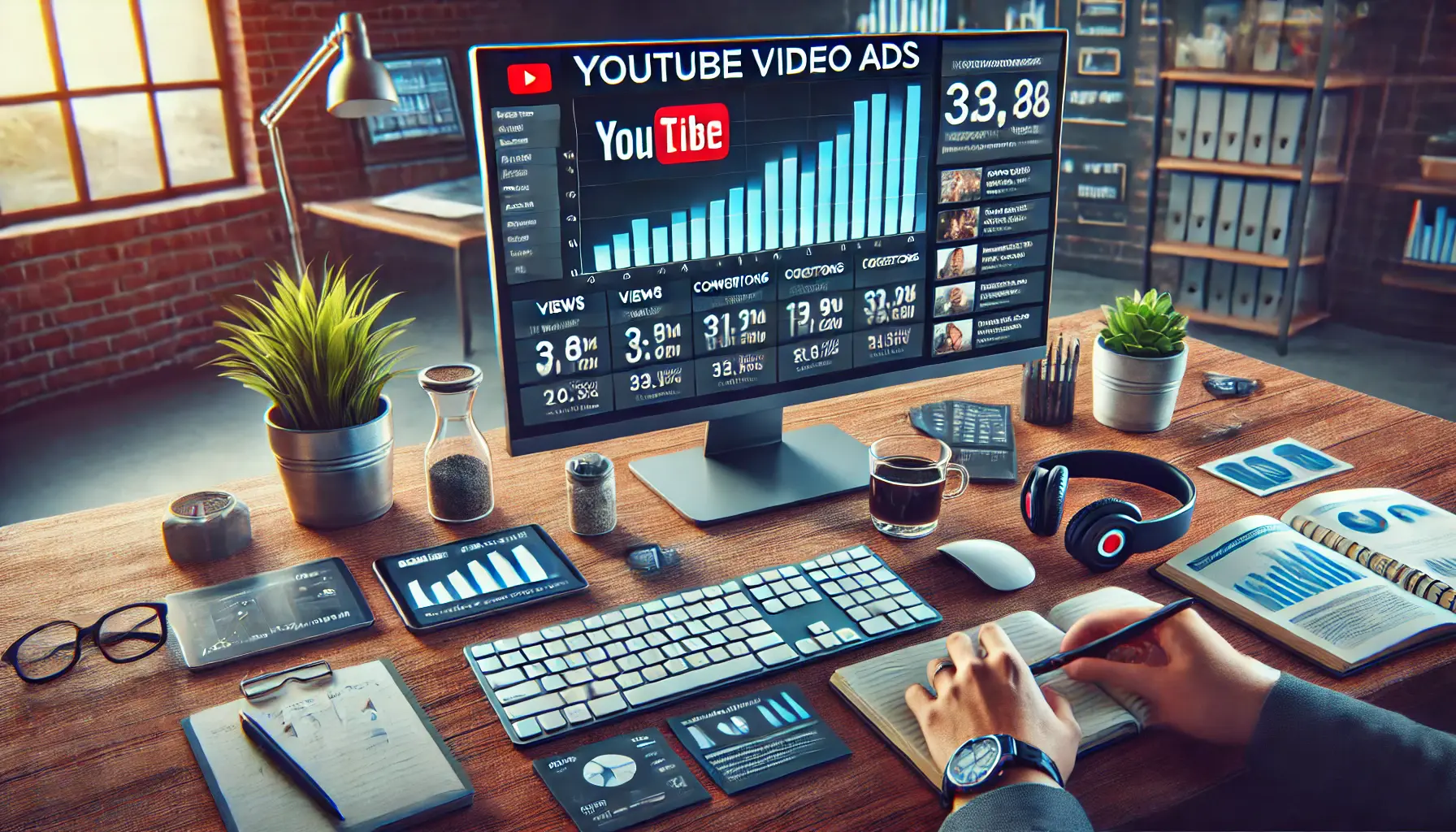
A workspace where a marketer is measuring the success of YouTube video ads using performance metrics.
Measuring the Success of Your YouTube Video Ads
After your YouTube video ads have gone live, it’s essential to measure their effectiveness.
Analyzing their performance helps you identify what worked well and what didn’t, allowing you to refine future campaigns.
By tracking key metrics, you gain insights into the performance of your campaigns and can take actionable steps to improve them.

A workspace where a marketer is reviewing KPIs for YouTube video ads.
Key Performance Indicators (KPIs) to Track
Tracking KPIs helps you understand exactly how well your video ads are performing:
- Views: The total number of times your ad was viewed, indicating the reach of your campaign.
- View Through Rate: The percentage of people who viewed your ad after it was served, measuring engagement levels.
- Click-Through Rate (CTR): The ratio of viewers who clicked on your ad to those who viewed it, showing the effectiveness of the call-to-action.
- Conversion Rate: The number of viewers who took a desired action, such as making a purchase or signing up, after clicking on your ad.
- Cost Per View (CPV): The average cost paid each time someone views your ad.
- Return on Ad Spend (ROAS): The revenue generated for every dollar spent on advertising, reflecting the overall profitability of your campaign.

A workspace where a marketer is leveraging YouTube analytics and Google Ads reports for ad optimization.
Leveraging YouTube Analytics and Google Ads Reports
Use YouTube Analytics and Google Ads reports to gain deeper insights into your ad performance:
- Audience Demographics: Identify the age, gender, and geographic location of your viewers to inform future content targeting.
- Traffic Sources: Track where your viewers are coming from, such as direct searches, suggested videos, or external websites.
- Engagement Metrics: Assess likes, shares, comments, and watch time to gauge viewer interaction with your ad.
- Device Performance: Understand how your ads perform across different devices, such as mobile and desktop, to optimize for the best user experience.

A workspace where a marketer is optimizing ad strategies through data-driven insights.
Data-Driven Optimization of Strategies
Refine your advertising strategies based on the data collected:
- Optimize Bidding Strategy: Increase your budget for high-performing ads or reduce spending on underperforming ones.
- Test New Creative Formats: Experiment with different ad formats or lengths to identify what works best with your audience.
By regularly monitoring these metrics and adjusting your strategies based on insights, you can enhance the performance of your YouTube video ad campaigns and achieve your desired marketing results.
Evaluating key performance indicators helps refine ad content and targeting for higher engagement and conversions.
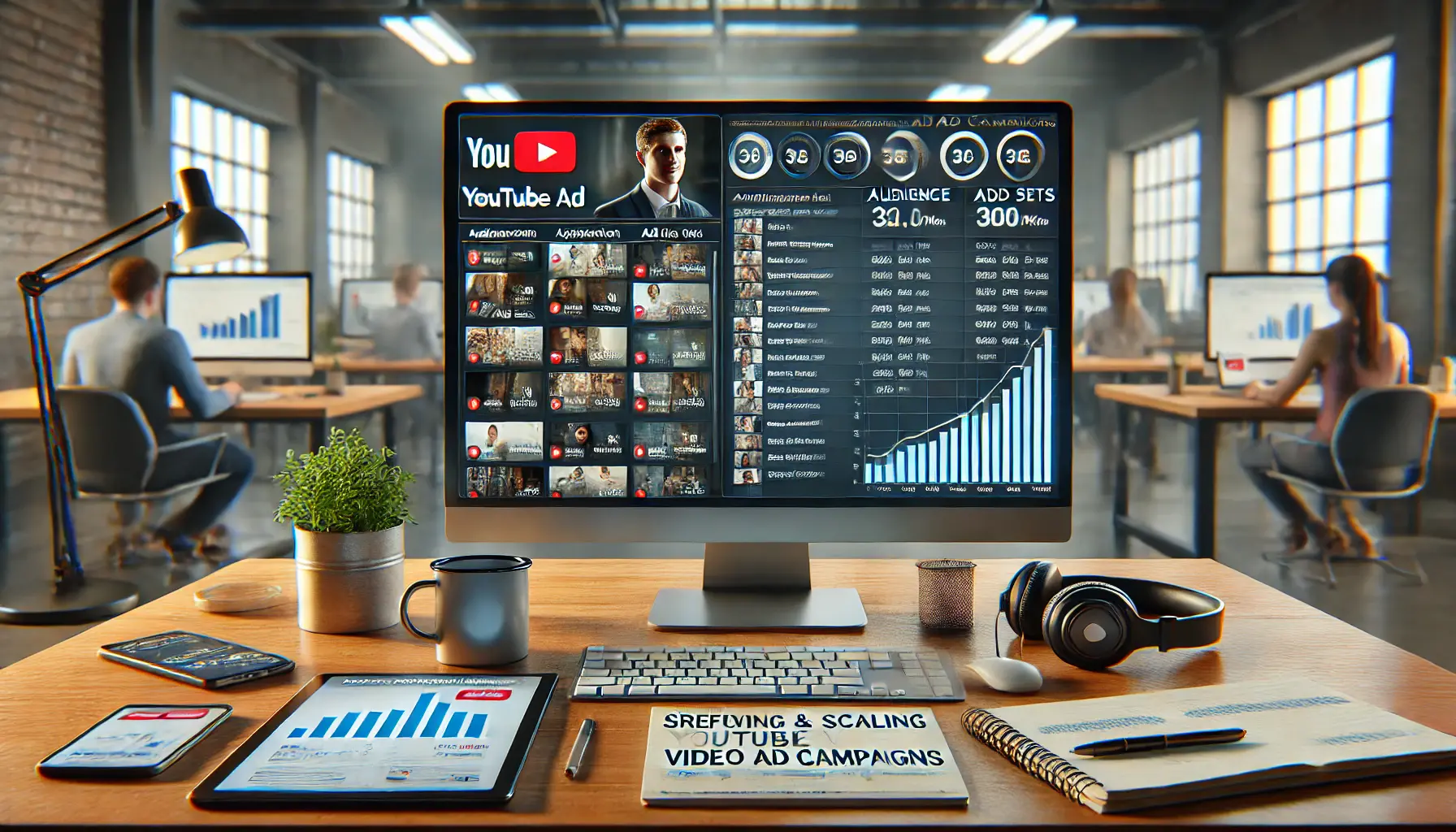
A workspace where a marketer is planning to scale YouTube video ad campaigns.
Scaling Your YouTube Video Ad Campaigns
Once you’ve created successful YouTube video ads, the next step is to scale your campaigns to reach a wider audience and maximize your return on investment.
Effective scaling requires strategic planning and continuous optimization.
Let’s discuss some key strategies for scaling your YouTube advertising.

A workspace where a marketer is expanding the reach of YouTube video ads through horizontal scaling.
Horizontal Scaling: Expanding Your Reach
Horizontal scaling involves expanding your audience base by introducing new campaigns or targeting different audience segments.
Consider the following approaches:
- New Audience Segments: Identify and target additional demographic or interest-based segments that align with your product or service.
- Different Creative Ad Formats: Experiment with other YouTube ad formats like bumper ads and discovery ads to engage users in new ways.
- Leverage Multiple Platforms: Extend your video ads to Google’s Display Network or other social media platforms to increase reach and visibility.
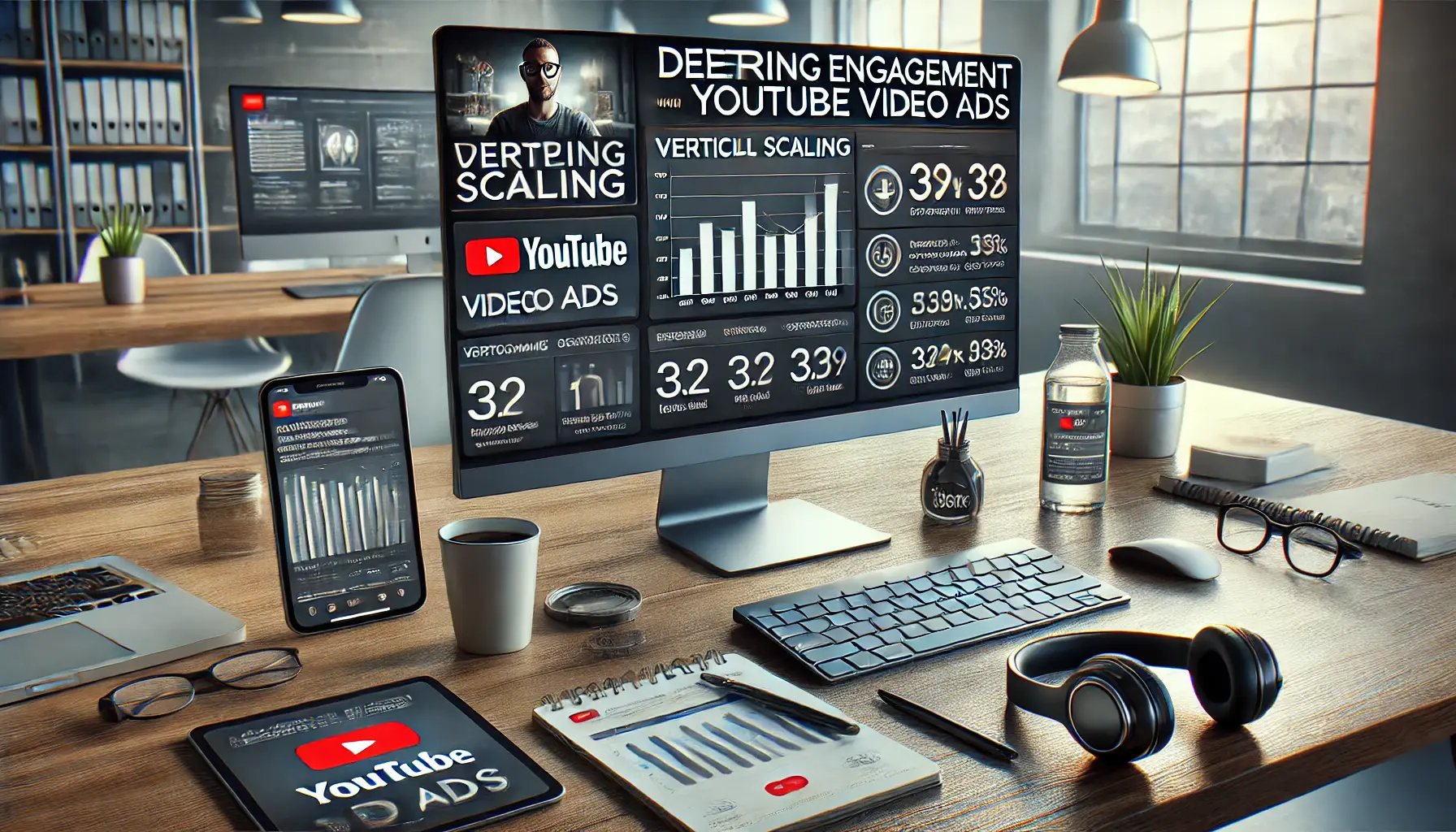
A workspace where a marketer is refining YouTube video ads to deepen engagement through vertical scaling.
Vertical Scaling: Deepening Engagement
Vertical scaling focuses on enhancing engagement within your existing audience.
Try the following strategies:
- Increase Ad Spend on High-Performing Campaigns: Allocate more budget to ads showing strong performance metrics.
- Optimize Ad Content: Refine your video content by considering audience feedback and performance data to boost effectiveness.
- Enhance Targeting Precision: Use advanced targeting options, such as custom affinity audiences, to reach users more likely to convert.

A workspace where a marketer is running A/B testing for continuous improvement of YouTube video ads.
Run A/B Testing for Continuous Improvement
Regular A/B testingA method to compare two versions of a variable to see which performs better. helps identify what resonates most with your audience.
You can test various elements, including:
- Ad Creative: Test different video concepts to determine which drives the highest engagement.
- Call-to-Actions (CTAs): Experiment with different CTAs to see which prompts more interaction.
- Ad Placement: Evaluate the effectiveness of ads in different placements to identify the most impactful positions.

A workspace where a marketer is monitoring and optimizing YouTube video ad performance metrics.
Performance Metric-Based Monitoring and Optimization
Continuous monitoring allows for timely adjustments to keep your campaigns performing at their best:
- Track KPIs: Regularly review metrics like view rates, CTR, and conversion rates to assess performance.
- Adjust Bidding Strategy: Modify bids based on performance data to ensure cost-effective ad placements.
- Refine Targeting Parameters: Update targeting based on audience insights to maintain relevance.
Using these strategies, you can scale your YouTube video ad campaigns effectively, reaching a larger audience while maintaining or even improving engagement and conversion rates.
Scaling campaigns requires strategic planning, targeting new audiences, and increasing investment in high-performing ads.
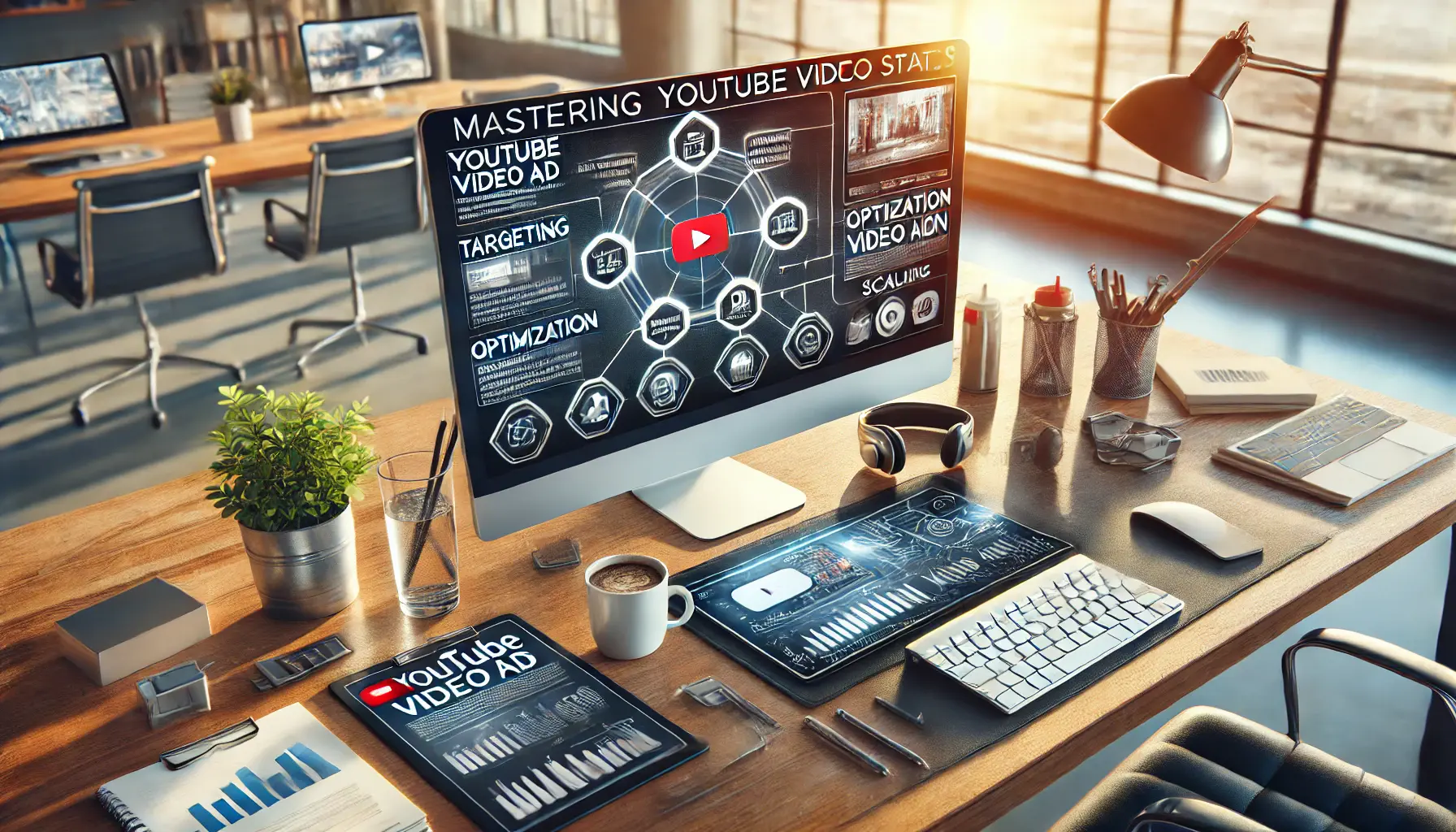
A workspace where a marketer is mastering YouTube video ads by strategizing and planning the roadmap to success.
Mastering YouTube Video Ads: The Roadmap to Success
Mastering YouTube video ads requires a strategic approach that combines creativity with analytics to ensure viewer engagement, performance optimization, and effective campaign scaling.
With the steps covered in this guide, you are now well-equipped to make a lasting impact with your video ads on YouTube.
Let’s summarize the key points and takeaways.
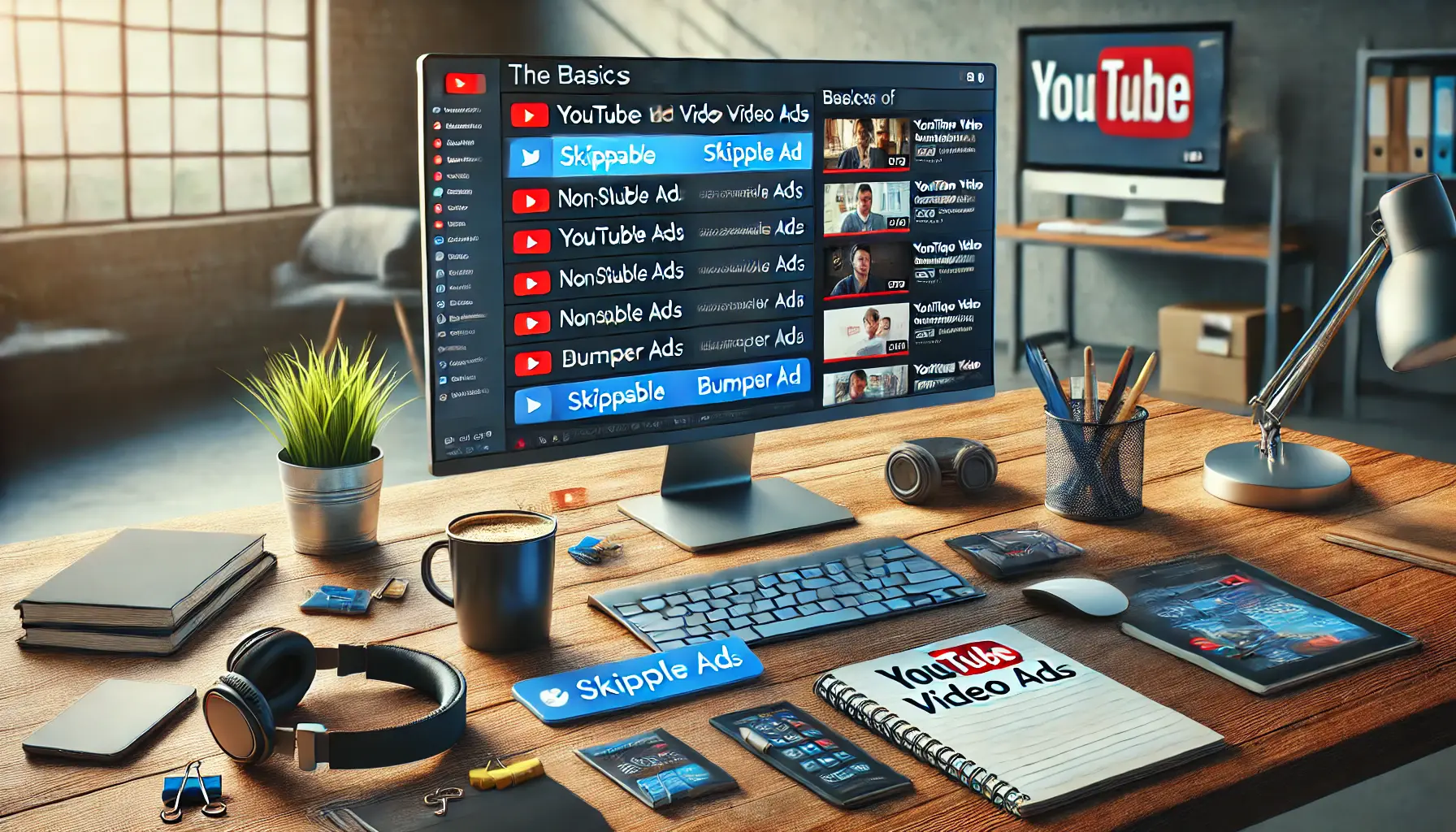
A workspace where a marketer is learning the fundamentals of YouTube video ads.
Understanding the Basics of YouTube Video Ads
Successful video advertising starts with selecting the right format and placement options.
Whether you opt for a skippable, non-skippable, or discovery ad, each type aligns with specific objectives—from building awareness to driving conversions.
Knowing where an ad will appear on the platform makes all the difference in reaching the right audience at the right time.

A workspace where a marketer is crafting engaging content for a YouTube video ad.
Creating Content That Resonates
Engagement is at the core of every successful YouTube ad.
This involves starting with a strong hook, crafting a relatable story, and maintaining high production value.
Engaging content ensures that your ads not only capture attention but also encourage viewers to take action.
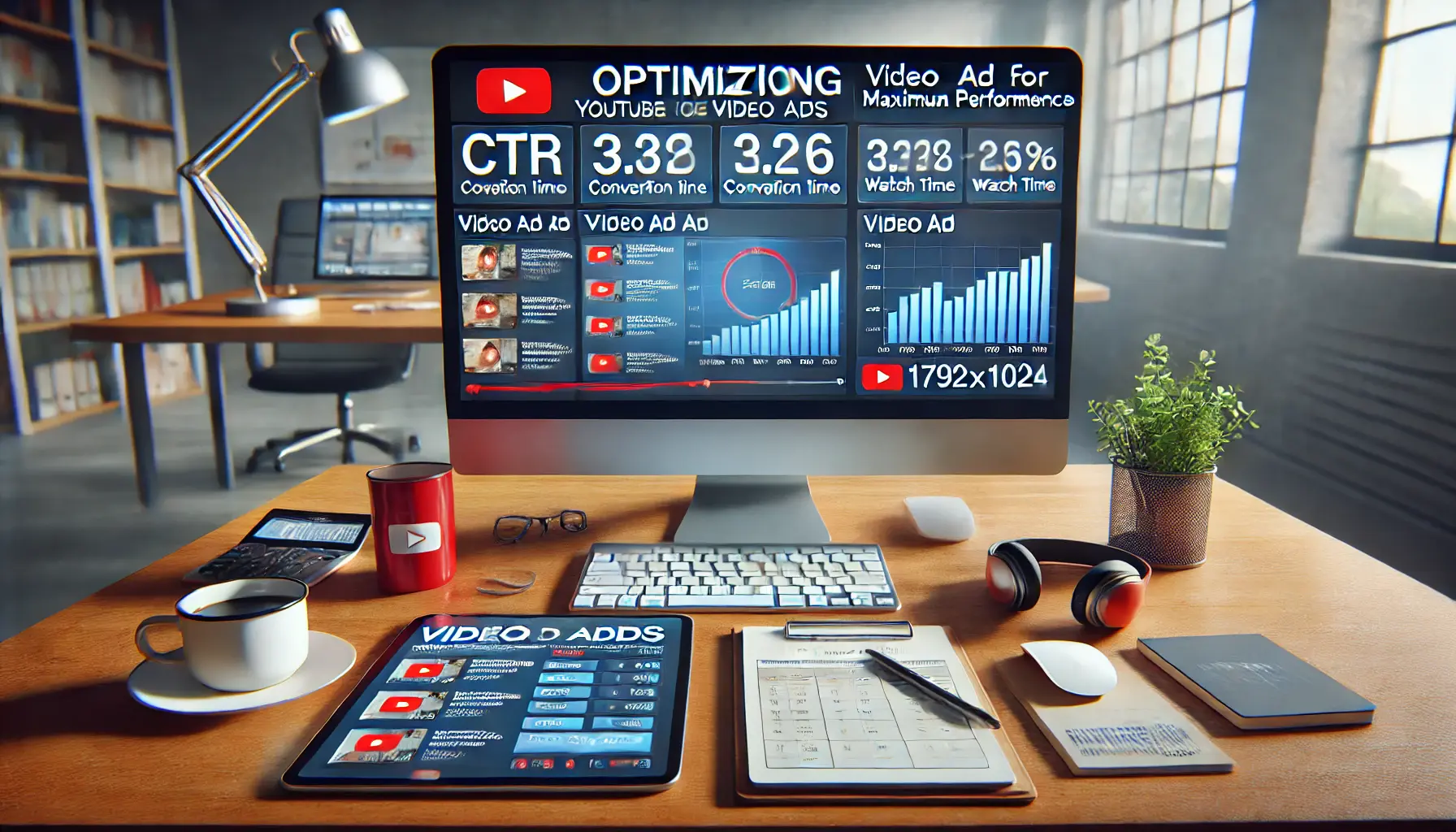
A workspace where a marketer is optimizing YouTube video ads for better performance.
Optimizing Video Ads for Maximum Performance
To achieve the best results, optimization is essential.
Using YouTube Analytics and regular A/B testing allows you to fine-tune ad elements for improved performance.
Tracking key metrics, including view rate, CTR, and audience retention, helps you understand what works and what doesn’t, enabling you to enhance engagement.

A workspace where a marketer is targeting the right audience for YouTube video ads.
Targeting the Right Audience
Effective targeting ensures that your ads reach the people most likely to engage with and respond to your message.
You can leverage YouTube’s demographic, interest, and custom affinityA targeting option based on users’ interests and habits. targeting options to connect with users who are highly relevant to your brand.
Setting up remarketingA tactic to re-engage users who have previously interacted with a brand. strategies helps you re-engage past viewers, keeping your brand top of mind.
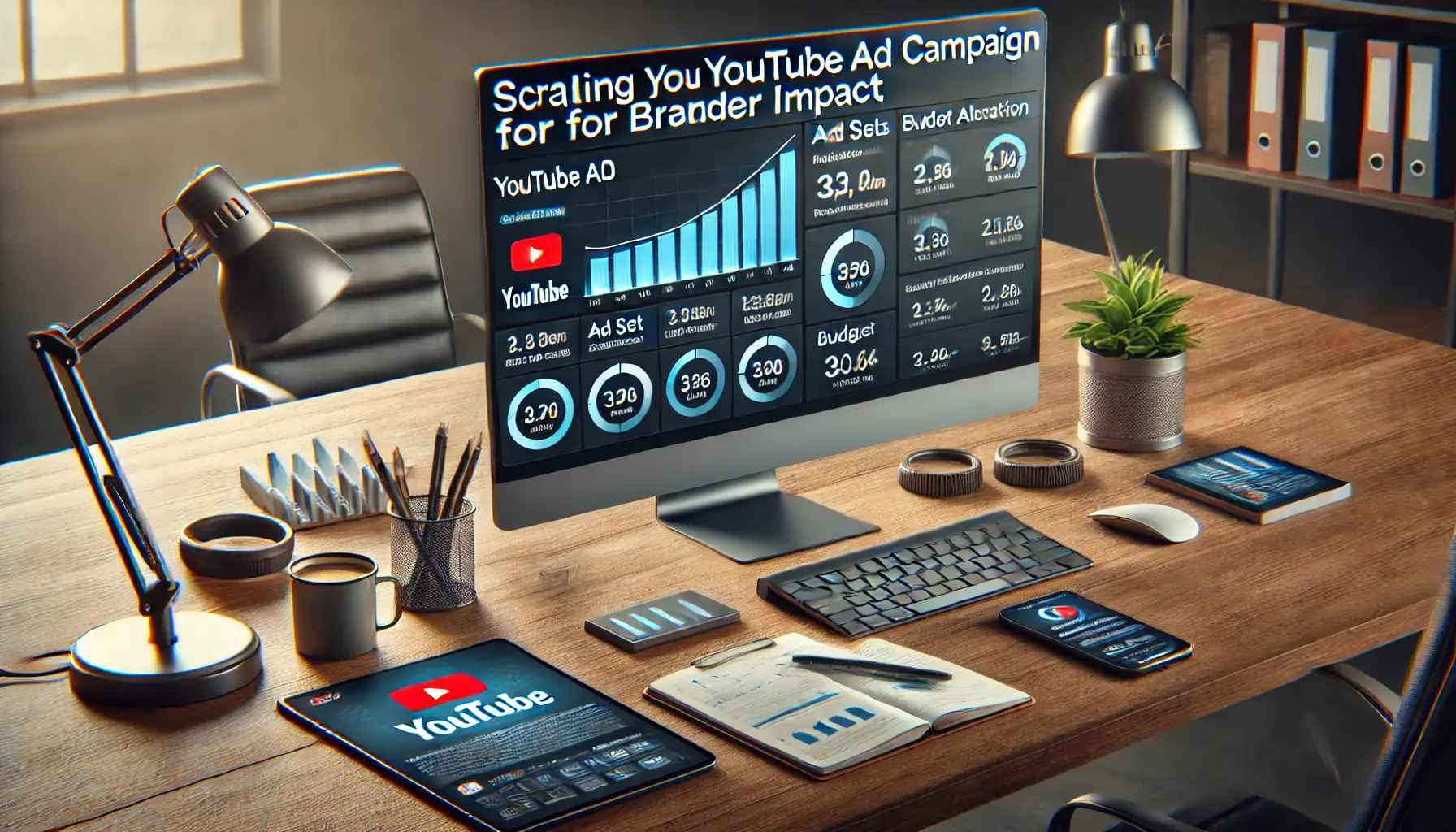
A workspace where a marketer is scaling YouTube ad campaigns for a wider impact.
Scaling Campaigns for Broader Impact
Scaling involves both broadening and deepening your ad strategy.
You can scale horizontally by reaching new segments of your target audience or scale vertically by investing more in high-performing campaigns.
Continuous testing and adjustments based on performance metrics ensure data-driven decisions that support efficient scaling without losing engagement.
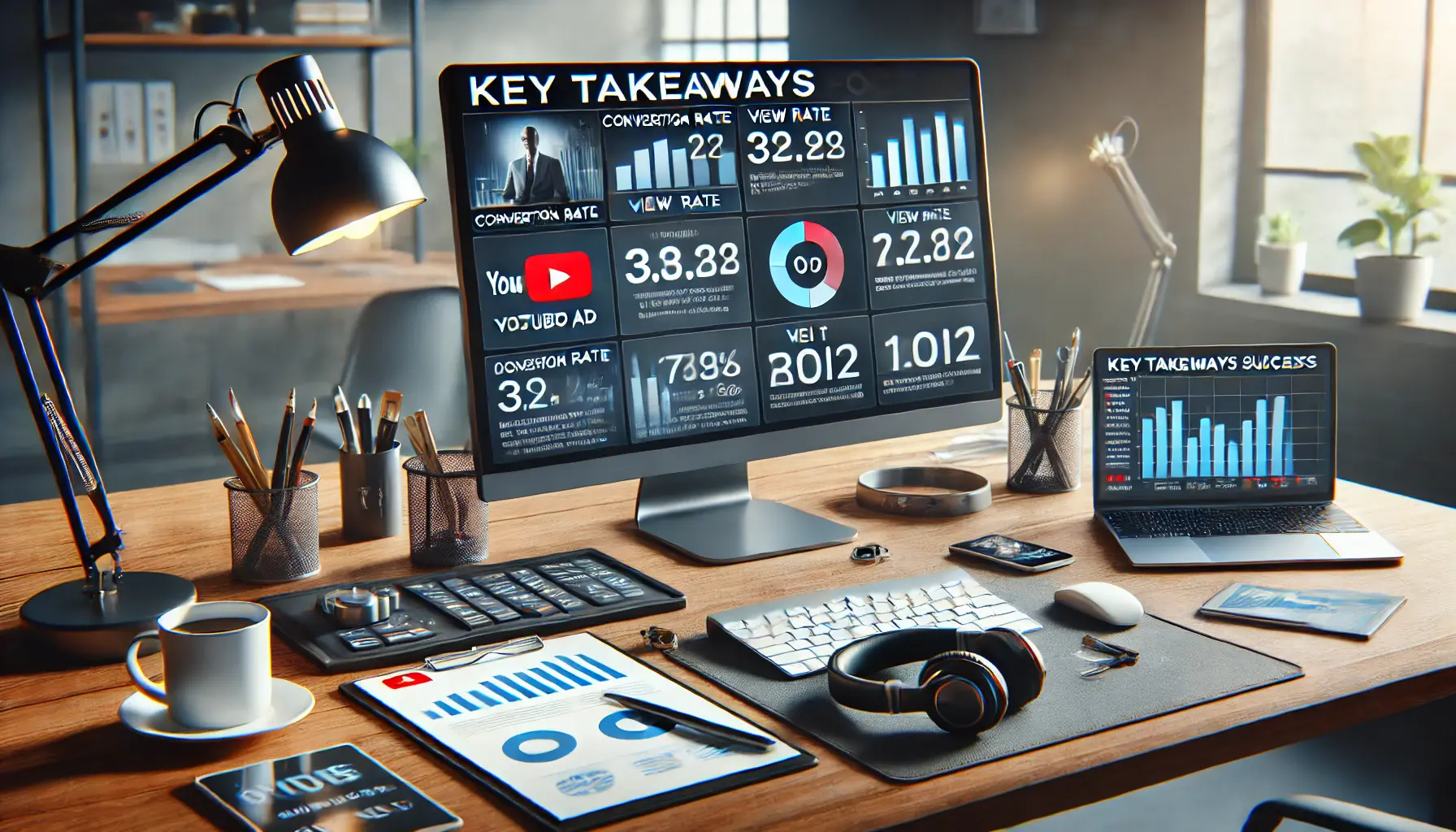
A workspace where a marketer is consolidating insights for YouTube video ad success.
Key Takeaways for YouTube Video Ad Success
As you work on honing your YouTube video ad skills, keep the following points in mind:
- Define Clear Objectives: Be clear about what you want to achieve with each ad, from brand awareness to lead generation and conversions.
- Create Compelling Content: Use strong storytelling, professional visuals, and an engaging CTA to capture and hold viewer interest.
- Optimize and Test Continuously: Monitor metrics and perform A/B testing regularly to optimize your ads for maximum performance.
- Scale Thoughtfully: Balance expanding reach with maintaining engagement, using data-driven insights to guide your scaling efforts.
By following these steps, you can transform your YouTube video ads into powerful drivers of brand growth, engagement, and conversions.
This guide serves as a roadmap to navigate the complex landscape of YouTube advertising, empowering you to achieve lasting success.
Mastering YouTube video ads combines creativity, targeting, and performance analytics to maximize brand impact.
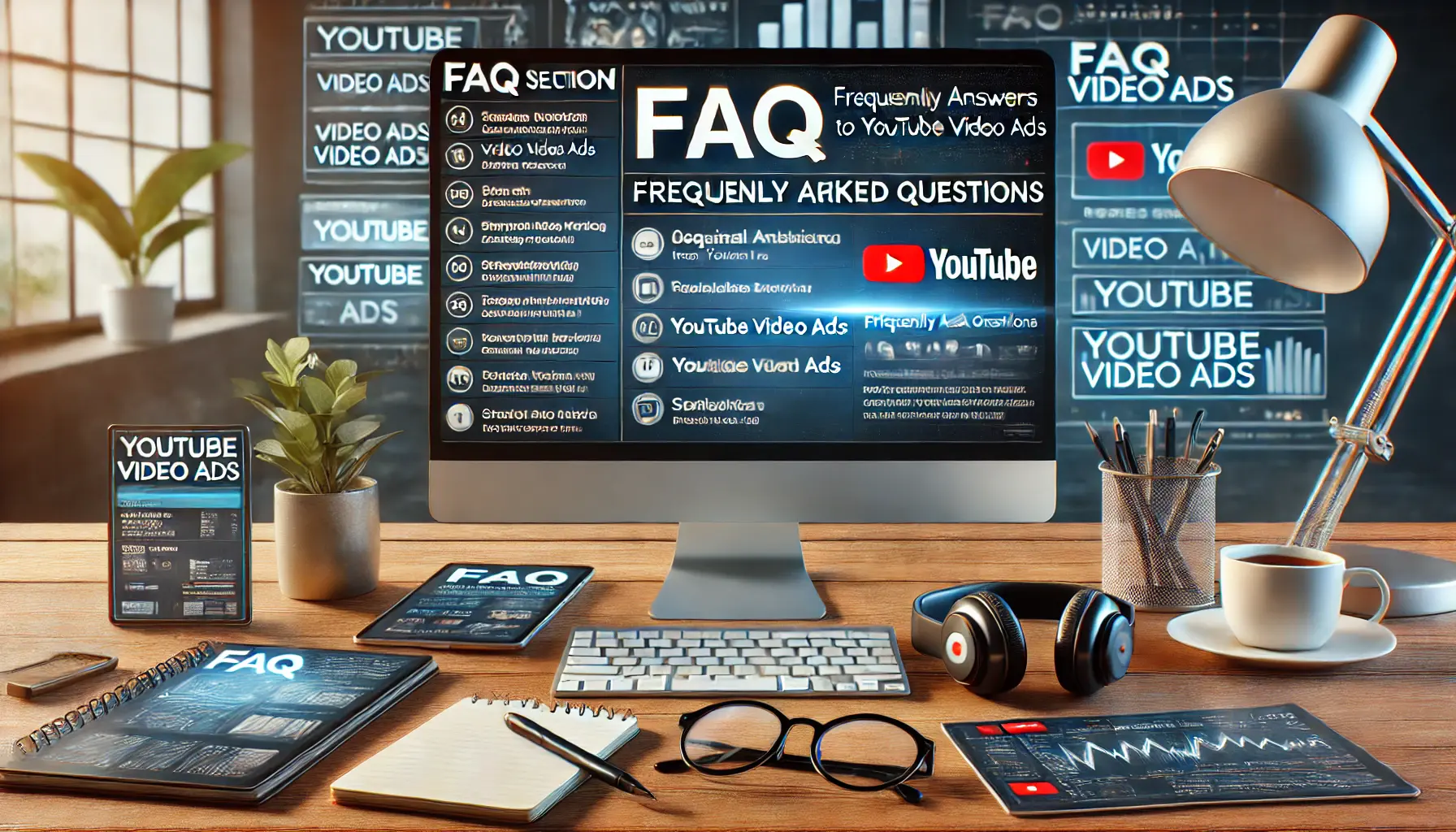
A workspace where a marketer is reviewing YouTube video ad frequently asked questions (FAQ).
Your campaigns can be managed by an agency specialized in Google Ads, check out our service page.
YouTube Video Ad Frequently Asked Questions
The following are some of the most common questions with quick answers to guide you in using YouTube video advertising effectively.
YouTube offers skippable in-stream ads, non-skippable in-stream ads, bumper ads, and discovery ads for different advertising objectives.
Costs depend on targeting and competitiveness, typically ranging from $0.10 to $0.30 per view.
Use YouTube’s targeting options, such as demographics, interests, and behaviors, to reach your desired audience.
The main metrics to track are view rate, click-through rate (CTR), watch time, and conversions to assess ad effectiveness.
Regularly analyze performance data, run A/B tests, and fine-tune targeting and creative elements to improve performance.
Ad length depends on objectives: shorter ads (6-15 seconds) work well for brand awareness, while longer ads (up to 60 seconds) suit detailed messaging.
YouTube video ads are specific to YouTube.
To advertise on platforms like TikTok or Instagram, create platform-specific campaigns.
To capture viewers’ attention, start with a hook, tell a compelling story, and include a clear call-to-action in your ad content.
Understand ad formats, target the right audience, create engaging content, and continuously optimize using performance data.




